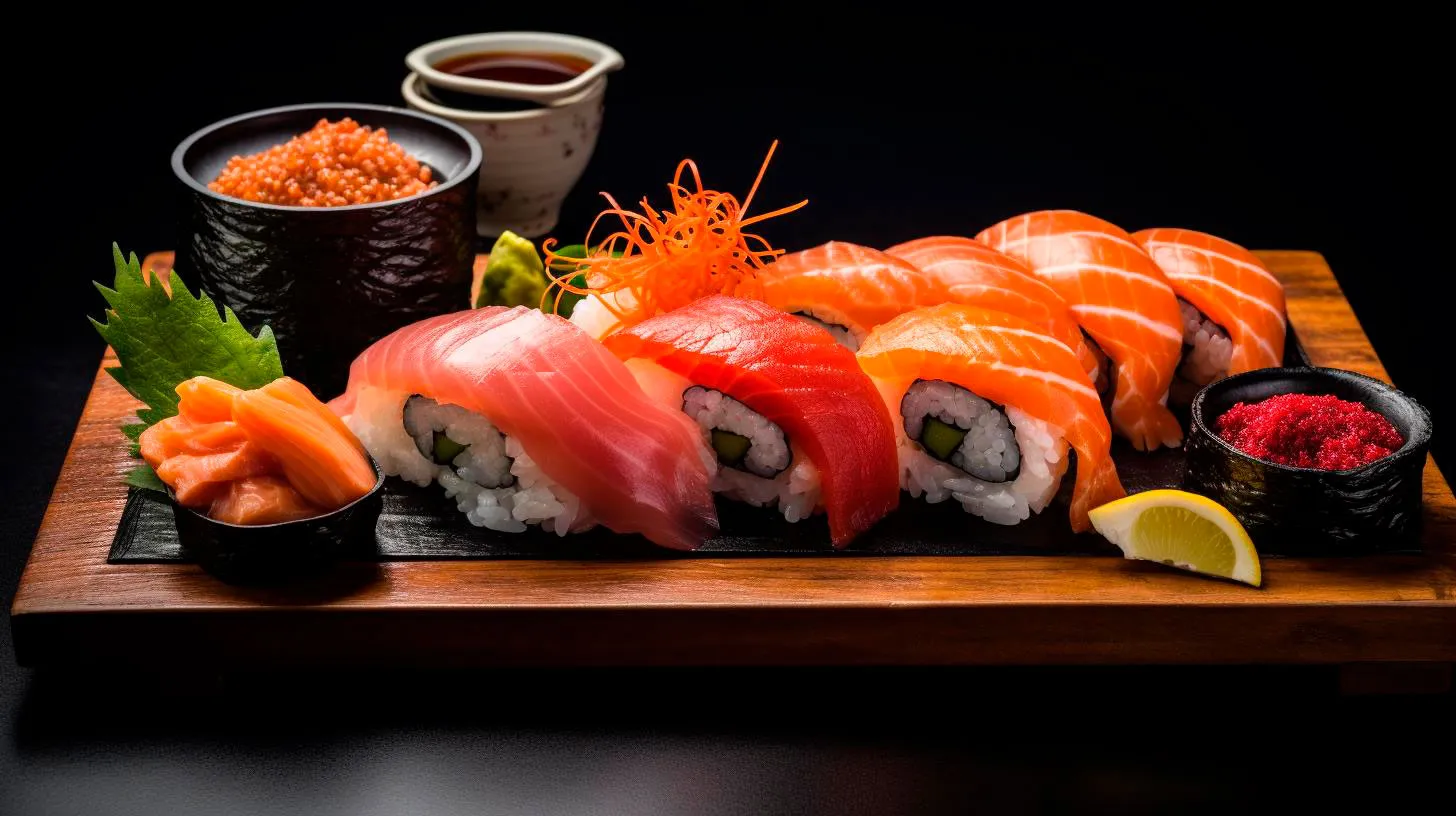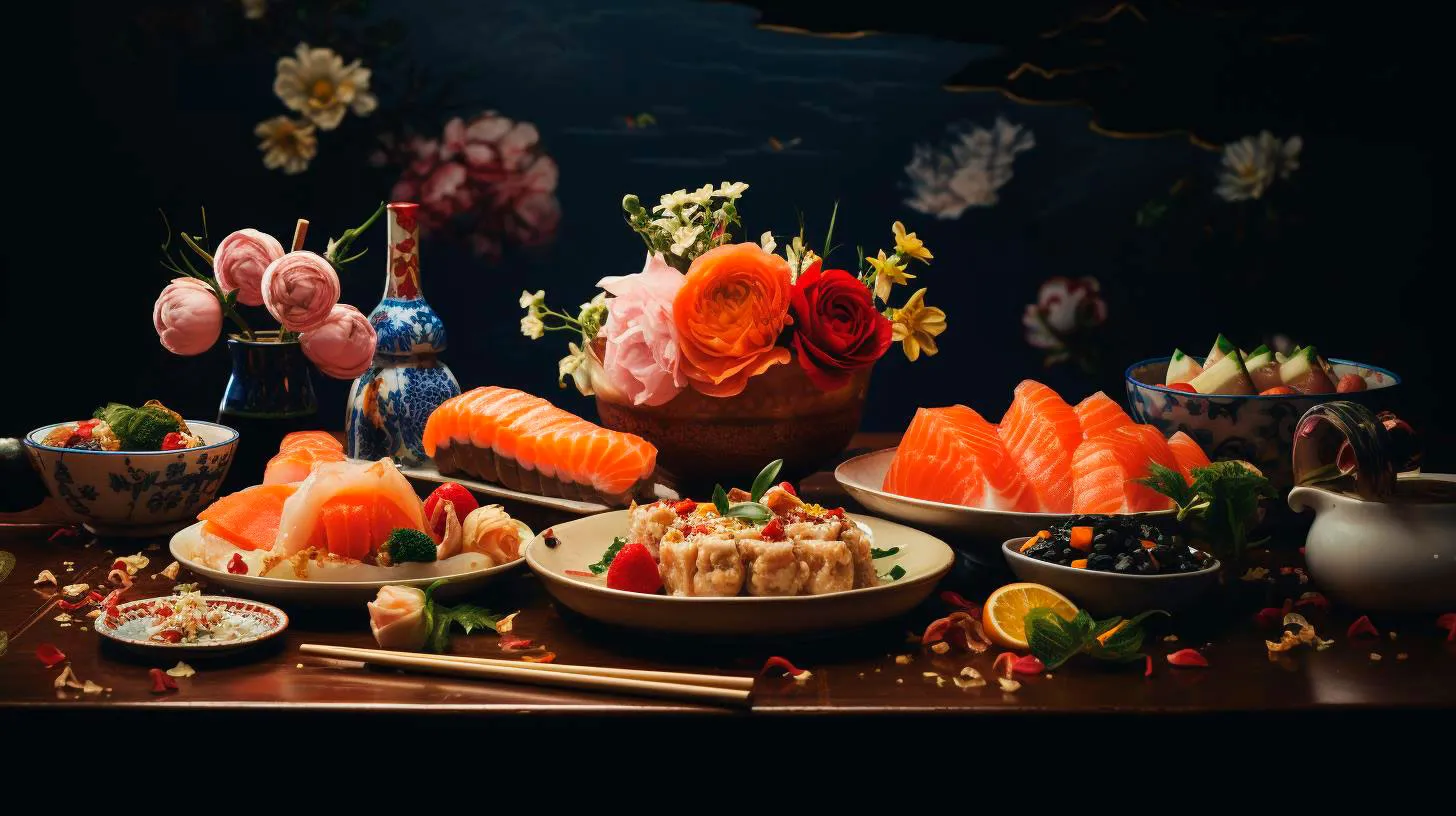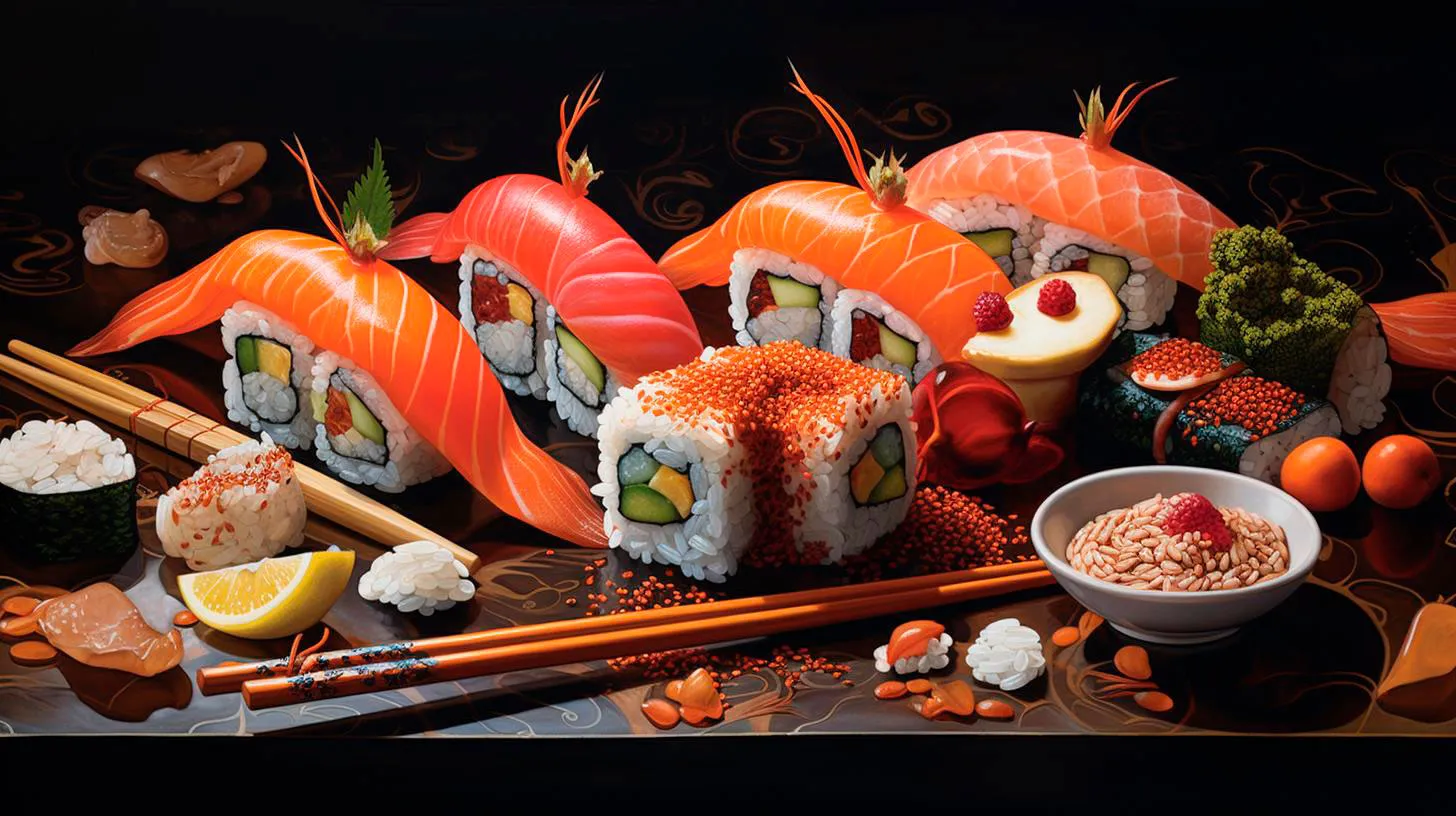Sushi and Cultural Integration: Exploring the Global Impact of a Japanese Delicacy
A Brief History of Sushi
Sushi has a rich history that dates back over a thousand years. Originating in Southeast Asia as a means to preserve raw fish, it was the Japanese who transformed sushi into the artful, flavorful creation we know today. In the early 19th century, sushi began to evolve with the introduction of vinegar-seasoned rice, known as shari. This innovation, combined with a variety of toppings and fillings, gave birth to the popular sushi rolls we enjoy today.
While sushi initially gained popularity within Japan, it wasn’t until the mid-20th century that it truly went global. With Japanese migration and the rise of international travel, sushi began to capture the taste buds of people from different cultures and backgrounds.
Sushi’s Journey to Global Fame
The globalization of sushi can largely be attributed to its unique blend of taste, presentation, and health benefits. This exotic delicacy offers an array of advantages that have captivated culinary enthusiasts worldwide:
- Health Benefits: Sushi is known for its nutritious ingredients and low-calorie count, making it a popular choice among health-conscious individuals.
- Art of Presentation: Sushi’s meticulous preparation and beautiful presentation appeal not only to the taste buds but also to the eyes. It has become a favorite on social media platforms where users showcase their sushi platters.
- Cultural Experience: By embracing sushi, individuals can immerse themselves in Japanese culture. Sushi restaurants often provide an authentic ambiance, giving customers a glimpse into the rich traditions of Japan.
- Variety and Customization: Sushi offers endless possibilities for customization, allowing diners to choose from a wide range of ingredients, toppings, and sauces to cater to their personal preferences.
These factors, combined with globalization and an increased appreciation for international cuisine, have propelled sushi to unparalleled fame.
The Role of Sushi in Cultural Integration
Sushi has played a significant role in cultural integration by fostering an appreciation for Japanese traditions and bridging gaps across diverse communities. Here’s how sushi has contributed to this profound cultural exchange:
- Cross-Cultural Adaptation: As sushi made its way into foreign markets, it adapted to local tastes and preferences. This process led to the creation of fusion sushi, incorporating ingredients from different cultures, further blurring the lines of culinary traditions.
- Japanese Culinary Diplomacy: With sushi gaining international recognition, it has become a symbol of Japanese cultural diplomacy. Through sushi, Japan has been able to promote its cuisine, language, and unique customs on a global scale, fostering understanding and appreciation between nations.
- Global Collaboration: Sushi’s popularity has resulted in collaborations between Japanese sushi chefs and international chefs. This exchange of ideas and techniques has influenced the evolution of sushi and led to the creation of unique flavors that blend cultures.
- Shared Dining Experiences: Sushi’s communal dining style, often centered around a sushi bar, encourages social interaction and bonding. People from various backgrounds come together to experience the art of sushi, promoting inclusivity and cultural understanding.
The Growing Global Influence of Sushi
The impact of sushi on cultural integration continues to grow, as demonstrated by the following industry statistics:
- According to the World Sushi Cup, there are approximately 45,000 sushi restaurants worldwide, outside of Japan.
- In the United States alone, the sushi industry generates over $2 billion in revenue annually.
- Research shows that sushi consumption in China increased by 30% in the last decade, reflecting the global demand for this Japanese delicacy.
These figures illustrate the increasing popularity of sushi and its ability to transcend cultural boundaries.
Key Takeaways
Sushi’s journey from a traditional Japanese dish to a global culinary sensation highlights the power of cultural integration. As sushi conquered the world, it fostered cross-cultural adaptation, encouraged collaboration, and united individuals from diverse backgrounds. Key takeaways from the global impact of sushi include:
- Sushi’s popularity stems from its health benefits, presentation, and customization options.
- Sushi’s global fame showcases the shared appreciation for international cuisine.
- Sushi plays a crucial role in cultural integration, promoting understanding and appreciation for Japanese traditions.
- Sushi’s influence is evident through collaborations, fusion sushi, and communal dining experiences.
- The industry statistics emphasize the widespread popularity and increasing demand for sushi worldwide.
With every sushi roll consumed, cultural integration finds a place at the dining table. Sushi not only satisfies hunger but also nourishes cultural understanding, allowing individuals to savor the world on a plate.
The Ancient Roots of Sushi: A Journey through Cultural Evolution
Join us on a journey through time as we explore the ancient roots of sushi and its fascinating cultural evolution.
The Origins: Early Beginnings
Sushi, in its earliest form, traces back to Southeast Asia. The concept of fermenting fish in rice originated as a way to preserve the catch for longer periods of time. This process was prevalent in countries such as China, where salted fish was layered with rice and left to ferment. Over time, this method made its way to Japan and acquired its own unique identity.
While the foundations of sushi were established in Southeast Asia, it was in Japan where it truly flourished and evolved into the dish we know today. During the Muromachi period (1336-1573), sushi became popular among the commoners, and street vendors started to offer it as a quick and affordable snack. It was during this time that sushi began to take on its distinctive style.
The Edo Period: Revolutionizing Sushi
The Edo period (1603-1868) marked a significant turning point in the history of sushi. It was during this time that sushi was revolutionized, thanks to the innovation of Hanaya Yohei, a sushi chef in Tokyo. Hanaya Yohei created the nigiri-zushi style, which involved placing a slice of raw fish on top of a small mound of vinegared rice. This technique allowed the flavors of the fish and rice to complement each other perfectly, creating a harmonious combination.
Advantages of the nigiri-zushi style:
- Enhances the flavors of both the fish and rice
- Provides a visually appealing presentation
- Offers a balanced and satisfying bite
During the Edo period, sushi became increasingly popular among the affluent class, and dedicated sushi restaurants began to emerge. The establishment of these sushiya, as they were called, created a refined dining experience centered around sushi.
The 20th Century: The International Rise of Sushi
While sushi had been a staple in Japan for centuries, it wasn’t until the 20th century that it gained global recognition. In the 1960s, sushi started to captivate the palates of Americans, especially in cities like Los Angeles and New York. However, it was not an easy journey to popularize this traditional Japanese cuisine in foreign lands.
A pivotal moment in the international rise of sushi came with the introduction of the California Roll. In the 1960s, sushi chef Ichiro Mashita developed this maki-zushi roll, which consisted of avocado, cucumber, and crab meat. The California Roll substituted raw fish with ingredients that were more familiar to Western tastes, making sushi more approachable for those new to the cuisine.
Key takeaways from the international rise of sushi:
- Innovation and adaptation are crucial for introducing a traditional cuisine to new cultures
- Understanding local preferences plays a significant role in expanding the popularity of a dish
- Creating accessible variations can help bridge the gap between unfamiliar and familiar flavors
Sushi Today: A Global Phenomenon
Today, sushi can be found in almost every corner of the world. With its beautiful presentation, fresh ingredients, and wide variety of flavors, it continues to captivate diners. Sushi has also evolved to accommodate diverse dietary preferences, with vegetarian and vegan options becoming increasingly popular.
According to industry statistics, the global sushi market is projected to grow at a CAGR of 3.5% from 2020 to 2025. This growth can be attributed to various factors such as the increasing popularity of Japanese cuisine, the rise of health-conscious eating habits, and the globalization of culinary experiences.
Key features of sushi in the modern era:
- Wide range of options catering to different dietary preferences
- Artistry and attention to detail in presentation
- Continued innovation and fusion with other cuisines
As sushi continues to evolve and adapt, it remains a testament to the rich cultural heritage of Japan. From its humble origins as a preservation technique to becoming a global phenomenon, sushi’s journey is a story of culinary excellence and cultural exchange.
In conclusion,
The ancient roots of sushi reveal its fascinating cultural evolution over time. Its origins in Southeast Asia, transformation during the Edo period, and international rise all contribute to its global popularity today. Whether you savor a traditional nigiri-zushi or explore creative rolls, every bite of sushi connects us to a rich culinary history.
Celebrating Tradition: Sushi’s Role in Cultural Festivities and Rituals
Whether you’re a sushi aficionado or someone who has just started exploring the world of Japanese cuisine, understanding the role of sushi in cultural celebrations and traditions is a fascinating journey.
Ancient Origins and Significance
Sushi has a history that dates back over a thousand years. Originally, it was a method used to preserve fish in fermented rice, allowing it to last for months. Over time, it evolved into an exquisite culinary art form, combining fresh fish, vinegared rice, and various other ingredients.
Significantly, sushi has always been considered more than just a meal in Japanese culture. It has deep-rooted symbolic meaning and is often associated with prosperity, happiness, and good fortune. During special occasions and festivals, sushi plays a crucial role in expressing gratitude, honoring traditions, and bringing people together.
Key Takeaway:
- Sushi is not merely a delicacy but also a symbol of prosperity, happiness, and good fortune in Japanese culture.
Sushi in Celebratory Events
Throughout the year, Japan celebrates numerous festivals and events, many of which incorporate sushi in their customs. One such example is Hinamatsuri, also known as Doll’s Day or Girls’ Day, a celebration to pray for the health and happiness of young girls. During this festival, a special type of sushi called chirashizushi is prepared and enjoyed by families. Chirashizushi is a colorful dish made with vinegared rice, various toppings, and garnishes, symbolizing the coming of spring.
Another prominent festival that embraces sushi is Hanami, which marks the arrival of spring and the blooming of cherry blossoms. Friends and families gather under cherry blossom trees and indulge in a picnic called hanami. Sushi, along with other traditional Japanese dishes, is an essential part of this celebration, representing the beauty of nature and the ephemeral nature of life.
Furthermore, sushi plays a crucial role in wedding ceremonies, where it is served during the wedding banquet as a symbol of purity, fertility, and a wish for a prosperous future. It is not uncommon to see beautifully arranged sushi platters at these events, showcasing the artistry and craftsmanship of Japanese chefs.
Key Takeaways:
- Hinamatsuri and Hanami festivals incorporate sushi as a representation of the arrival of spring and the beauty of nature.
- In wedding ceremonies, sushi symbolizes purity, fertility, and a prosperous future.
Sushi in Traditional Rituals
Beyond festivals and celebrations, sushi also plays a role in various traditional rituals. One such example is the Buddhist custom of Oseibo. During Oseibo, people offer gifts to express gratitude and strengthen their relationships. Sushi, often in the form of beautifully packaged gift sets, is a popular choice to convey appreciation and well-wishes during this time.
Another significant ritual where sushi takes center stage is the celebration of the New Year, known as Oshogatsu. Families gather to enjoy a special meal called osechi, which consists of a variety of dishes, including sushi. Each sushi roll and ingredient has a symbolic meaning associated with warding off evil spirits, bringing prosperity, and attracting luck for the upcoming year.
Key Takeaways:
- Sushi is often exchanged as gifts during the Buddhist custom of Oseibo.
- Osechi, the traditional New Year’s meal, incorporates sushi with symbolic meanings for prosperity and luck in the coming year.
From festivals to rituals, sushi’s pervasive presence in Japanese culture enriches the meanings and connections established during these special occasions. The artistry, symbolism, and flavors of sushi make it an integral part of celebrating traditions and fostering a sense of togetherness.
So, the next time you savor a delectable sushi roll, remember the cultural significance behind each bite. Let it transport you to Japan, immersing you in a world where ancient traditions and culinary excellence intertwine.
Sushi From Humble Beginnings to International Culinary Icon
In this blog post, we will explore the fascinating journey of sushi from its early beginnings to its current status as a global culinary icon.
The Origins of Sushi
Sushi traces its roots back to ancient Japan, where it was first developed as a means of preserving fish by fermenting it with rice. This fermentation process helped extend the shelf life of fish, allowing it to be consumed even when fresh fish was unavailable. In the 17th century, a new method known as “Edo-style sushi” emerged, where fresh fish was placed on top of small balls of seasoned rice. This style of sushi laid the foundation for the modern sushi we enjoy today.
The Rise of Modern Sushi
In the early 19th century, Tokyo (formerly known as Edo) became the epicenter of sushi innovation. Chefs began experimenting with different ingredients and techniques, creating a variety of sushi styles. Nigiri sushi, which consists of a small piece of raw fish placed on top of a mound of vinegared rice, gained popularity during this time. The concept of sushi as an art form was also developed, with chefs paying great attention to the aesthetic appeal of their creations.
During the 20th century, sushi started to gain international recognition. In the 1960s and 1970s, Japanese immigrants brought sushi to the United States, particularly in California. It was initially met with skepticism, but soon gained a devoted following. As sushi spread across the globe, it underwent numerous adaptations to suit different culinary preferences. Today, sushi is not only enjoyed in traditional sushi bars but can also be found in supermarkets, convenience stores, and even fast-food restaurants.
The Health Benefits of Sushi
Sushi is not only delicious but also offers several health benefits. Here are some key advantages of incorporating sushi into your diet:
- Sushi is a great source of omega-3 fatty acids, which are essential for heart health.
- The combination of seafood and rice in sushi provides high-quality protein and essential amino acids.
- Sushi often includes seaweed, which is rich in vitamins and minerals, including iodine.
- Many types of sushi contain vegetables, offering a good source of fiber and antioxidants.
Sushi Trends and Innovations
In recent years, sushi has continued to evolve, both in terms of taste and presentation. Here are some notable sushi trends and innovations:
- Fusion Sushi: Sushi has been fused with cuisines from around the world, resulting in unique combinations and flavor profiles.
- Vegetarian and Vegan Options: Sushi restaurants now offer a variety of plant-based sushi options, catering to a growing demand for vegan and vegetarian alternatives.
- Sushi Burritos: A fusion of sushi and burritos, these oversized rolls are becoming increasingly popular, offering a convenient and customizable sushi experience.
- Sustainable Sourcing: With increasing awareness of environmental conservation, many sushi restaurants are committed to sourcing their ingredients sustainably, focusing on responsible fishing practices and reducing plastic waste.
In Conclusion
Sushi has come a long way from its humble beginnings as a preservation method to becoming a globally adored culinary icon. Its incredible journey, combining traditional techniques with modern innovations, has captivated food enthusiasts worldwide. With its health benefits, variety of flavors, and visually stunning presentation, sushi continues to be a beloved culinary delight that shows no signs of slowing down.
So, the next time you indulge in a fresh piece of nigiri or savor a sushi roll, take a moment to appreciate the rich history behind this beloved international delicacy.


